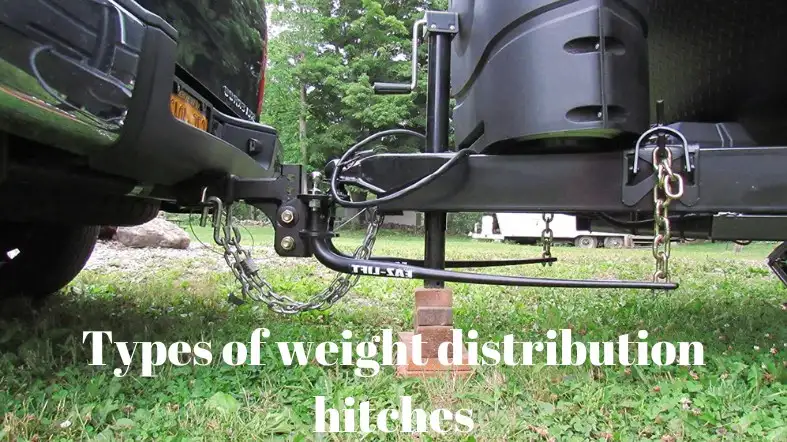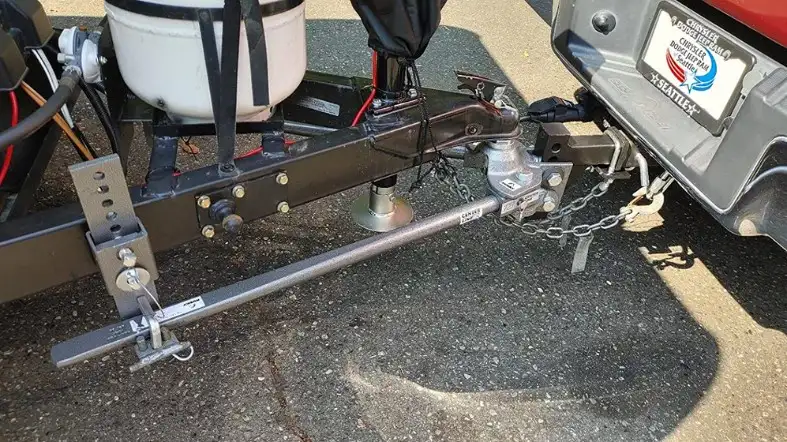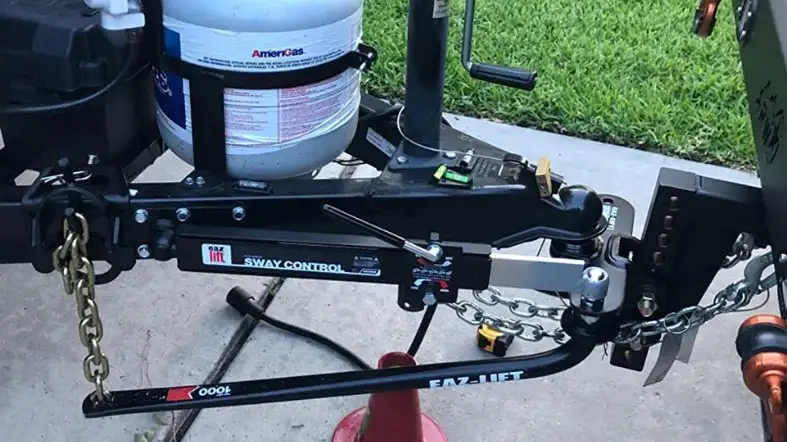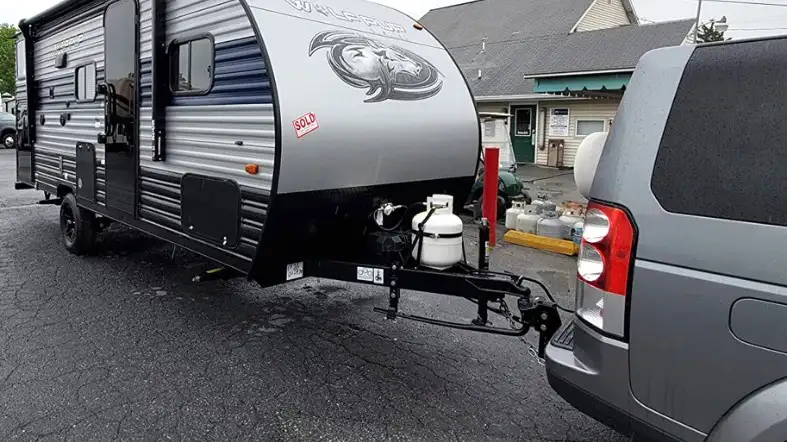Weight distribution hitches are an important tool for safely and effectively towing heavy loads with your vehicle.
There are a variety of different types of weight distribution hitches available, each designed to suit different needs and vehicles.
In this guide, different types of weight distribution hitches, for your vehicle.
Whether you are a seasoned towing professional or just starting out, we hope that this guide will help you get the most out of your weight distribution hitch.
Let’s get started!
Types of Weight Distribution Hitches
There are several different types of weight distribution hitches available.
Each type has its own set of pros and cons, so it is important to carefully consider your needs and preferences when choosing a weight distribution hitch.

1. Round Bar Weight Distribution Hitches:
Round bar weight distribution hitches are the most common type of weight distribution hitch used.
They use a round bar and which is then connected to the hitch head and tensioned using either a spring or a chain.
Pros
- Round bar weight distribution hitches are easy to install and use.
- They help to distribute the trailer tongue weight more evenly over the tow vehicle’s rear axle, resulting in improved stability.
- They provide a smoother ride by reducing the amount of bounce, sway, and fishtailing.
- They can be used with a variety of trailer weights and sizes.
Cons
- Round bar weight distribution hitches can be more expensive than other types of hitches.
- They are not as adjustable as other types of hitches, which can limit their use with certain trailers.
- They require more maintenance than other types of hitches, as the round bars need to be greased and inspected regularly.
- They can be difficult to install and adjust and can require special tools.
2. Sway Control Weight Distribution Hitches:

Sway control weight distribution hitches use a combination of spring bars and friction sway control devices to reduce side to side trailer movement.
Pros
- A sway control weight distribution hitch helps to improve the overall stability of your vehicle and trailer, reducing the risk of dangerous situations and accidents.
- By distributing the trailer’s weight more evenly, a sway control weight distribution hitch can improve the tow performance of your rig, allowing for greater control over the vehicle and trailer and reducing the risk of dangerous swaying.
- By reducing the risk of swaying, a sway control weight distribution hitch can help to keep you and other drivers safe on the road, making your driving experience much more secure.
Cons
- A sway control weight distribution hitch is usually more expensive than a standard weight distribution hitch, due to its more complex design.
- The added complexity of a sway control weight distribution hitch can also lead to higher maintenance costs.
- The increased weight distribution can also lead to reduced maneuverability on tight turns and sharp corners.
3. Trunnion Bar Weight Distribution Hitches:

Trunnion bar weight distribution hitches use two bars that are mounted on the trailer frame and a hitch head that attaches to the vehicle frame.
The bars are then connected to the hitch head and tensioned using a spring or chain.
Pros
- Trunnion bar weight distribution hitches provide a more stable and comfortable ride and help reduce swaying, especially when towing heavy loads.
- The trunnion bar weight distribution hitch is easy to install and provides a good range of adjustments.
- The bars are adjustable, so you can customize the weight distribution to match the load you are carrying.
- The trunnion bar weight distribution hitch is a cost-effective way to improve your towing experience.
Cons
- The trunnion bar weight distribution hitch can be difficult to adjust, particularly for first-time users.
- The weight distribution bars are not adjustable, so if you need to change the weight distribution, you need to purchase a new set of bars.
- The trunnion bar weight distribution hitch is not suitable for use with trailer brakes.
- The trunnion bar weight distribution hitch is not as efficient as other weight distribution hitches and can’t handle as much weight.
4. Dual Cam Weight Distribution Hitches:

Dual cam weight distribution hitches use two bars that are mounted on the trailer frame and a hitch head that attaches to the vehicle frame.
The bars are then connected to the hitch head and tensioned using two cam-style devices.
This type of weight distribution hitch is designed to provide greater control over sway and trailer movement.
Pros
- Dual cam weight distribution hitches allow for greater control and stability when towing large or heavy loads, allowing for a smoother and safer ride.
- Dual cam weight distribution hitches are designed to evenly distribute the weight of your trailer and cargo across the hitch and vehicle, reducing the risk of swaying and fishtailing while on the road.
- By improving the weight distribution of your trailer and cargo, dual cam weight distribution hitches also improve your vehicle’s handling. This is especially beneficial when making tight turns and maneuvering in narrow spaces.
Cons
- Dual cam weight distribution hitches are more expensive than traditional hitches and may not be cost-effective for those only needing to tow light loads.
- Installing a dual cam weight distribution hitch can be complicated and requires more time and effort than traditional hitches. It is important to read the instructions carefully and follow the steps precisely to ensure a safe and secure installation.
- Dual cam weight distribution hitches are often bulky and awkward to store.
How to choose the right weight distribution hitch for your needs?
- Determine the Gross Vehicle Weight Rating (GVWR) of your vehicle. This is the maximum weight that the vehicle is designed to carry.
- Add up the total weight of all the cargo that you plan to haul, including the weight of the trailer.
- Subtract the total weight of the cargo from the GVWR of your vehicle. This number is the amount of tongue weight that your vehicle can carry.
- Select a weight distribution hitch with a capacity that’s equal to or greater than the tongue weight of your vehicle.
- Choose a weight distribution hitch that is compatible with your vehicle’s towing capacity and trailer type.
- Consider the features and options available on the weight distribution hitch to ensure that it meets your needs.
FAQs About Types Of Weight Distribution Hitches
What Is A Weight Distribution Hitch?
A weight distribution hitch is a special type of hitch that is used to level a load of a trailer when it is being towed by a vehicle.
It works by transferring some of the tongue weight of the trailer to the axles of the vehicle that is towing it, which helps to level the load and improve the performance of both the trailer and the vehicle.
Are All Weight Distribution Hitches The Same?
No, weight distribution hitches vary in size, strength, and design.
Some are designed for lighter loads, while others are designed for heavier loads.
Additionally, some weight distribution hitches are adjustable, allowing you to adjust the tension on the spring bars to achieve the desired weight distribution.
What Are The Benefits Of Using A Weight Distribution Hitch?
Some benefits of using a weight distribution hitch:
1. Improved Vehicle Control
2. Weight distribution hitches ensure that the trailer’s load is evenly distributed and balanced.
3. Weight distribution hitches reduce the strain on the vehicle’s suspension and springs, which helps to prolong their lifespan and reduce the risk of wear and tear.
4. When the trailer’s weight is properly distributed, the vehicle’s engine does not have to work as hard to pull the trailer, which helps to improve its gas mileage.
Conclusion
Now that you know about the different types of weight distribution hitches, it’s time to pick the right one for your needs.
If you have a trailer or camper, make sure you get a hitch that will distribute the load evenly and keep your vehicle from bouncing around.
